Jodi365.com is excited to introduce a section on this blog that will traverse the country to find wedding traditions that all lead to one thing – getting married! This week, we look at a traditional Tamil Brahmin ceremony.
People might complain incessantly about an long-drawn wedding ceremony, but there’s something charming and quaint about it all. There is a sense of participation as a family’s closest relatives come together to get a couple married and wish them well. A Tamil Brahmin wedding incorporates rituals that are closest to the vedic traditions. Every aspect of the wedding is based on ancient wisdom that has been handed down over the ages to ensure that the marrying couple are blessed by everyone and everything.
The ceremony itself has been shortened over the years as lifestyles have changed. These days, a typical Tamil Brahmin wedding is completed in a matter of hours — down from four days a few generations ago! While some rituals hark back to the days of child marriage, others have a deeper significance in the lives of the couple getting married. If you long for a dash of tradition and fancy seeing yourself as part of the modern couple that understands the meaning behind wedding traditions, then the following summary is geared for you!
- Ganapati Pooja: It’s imperative to ask for Ganapati’s blessing’s at any event in one’s life, as his blessings remove every impediment and obstacle.
- Nandi Devata Pooja: The presiding deities (Nandi Devatas) are invoked with this pooja in which a leaf-laden branch of the peepultree is brought in and ablutions with milk are performed by five married women (sumangalis). Following this, the bride and groom are presented with clothes.
- Navagraha Pooja: Prayers are offered to the nine ruling planets, which are believed to govern our destinies.
- Paalikai: The pots for this fertility ritual are prepared a day before the wedding. Nine different kinds of cereal are pre-sown in an earthen pot by sumangalis from the bride’s household. After the wedding ceremony is over, these sprouted seeds are released into a water body.
- Vratham: Or fast. It is taken by the bride and groom separately. For the bride, thevratham is signified by the tying of a sacred thread or kaapu which will protect her from evil spirits. For the groom, however, taking a fast signifies his transition from one stage of life, that of a bachelor (Brahmachari), to the next: householder (Grihasta).
- Kankana Dharanam: The bride ties a yellow thread, fastened to a piece of dry tumeric, around the groom’s wrist, thus binding them in a religious vow. This ritual allows the groom the right to touch his bride. A little later, the groom does the same.
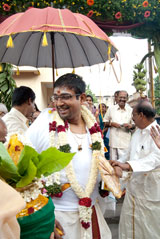
7. Kasi Yatra: A young man so used to the stoic life of a bachelor is not prepared for a life of cohabitation. He chooses a life of asceticism and makes his way to the holy city of Kasi (also known as Benares). The bride’s father intervenes and offers the young man a word of advice on married life and promises the young bachelor his daughter as companion. In the modern wedding ceremony, this yatra is undertaken symbolically.
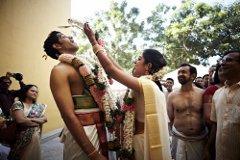
8. Maalai Mathal (garland exchange): One of the more fun rituals. The couple to be married, exchange garlands while being hoisted on the shoulders of their uncles.
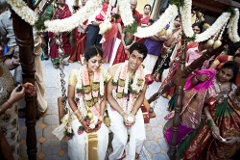
9. Oonjal: After the exchange of garlands, the couple is seated on a swing. As they swing back and forth, the women in their respective families sing beautiful compositions dedicated to the couple getting married. Symbolically, the chains of the swing represent the eternal cosmic, karmic link shared by the couple, while the oscillating swing represents the undulating waves of life. Despite an undulating swing, the couple remains united, steadfast, and stable in the face of adversity.
10. Mangala Arathi: A solution made of lime and tumeric powder, on a plate, is circled around the bride and groom a number of times by family elders to ward off the evil eye. This ritual is repeated a number of times at various junctures of the wedding ceremony.
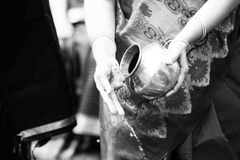
11. Vara Pooja: The groom is honored in this ceremony. His feet are washed in milk and wiped with a silk cloth. A circle of purity is made around the couple with pure water and oil lamps to ward off demon spirits. Little globes of colored rice are circled around the couple and discarded to ensure that evil spirits leave them be.
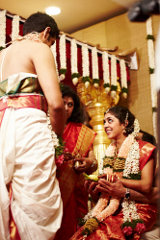
12. Kanya Daanam: The first official ritual to signify a woman leaving her birth family. The bride sits on her father’s lap, and is given away. On the girl’s head, a ring is made of sacred grass (dharba), and over this ring a yoke is placed. The gold thaali (mangal sutra) is placed on the yoke and water is poured. After this, the bride retires to her chamber where she will be helped by her sister-in-law-to-be into the koora podavai, the ceremonial saree worn for this occasion. The saree is an auspicious shade of maroon. A belt made of reed grass is tied around the bride’s waist. After the recital of sacred hymns, the bride is ready to be given over to her husband. The groom offers an assurance to the bride’s father that she will be his companion in joy and sorrow, in this life and forever after.
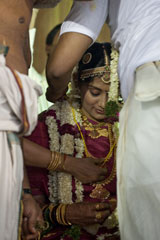
13. Mangalya Dharanam: The tying of the sacred thaali is timed down to the last auspicious second. The bride is seated on a mat of grain-laden hay facing east, while the groom faces west. He ties the thaali around the bride’s neck – one knot by him and the remaining two by his sister. As this happens, the drums are beaten loud so that any inauspicious noises are drowned out. The women gathered sing of the marriage of the holy deities, wishing that the couple getting married have a union as strong.
14. Paani Grahanam: Literally means “holding hands”. The bride’s closed palm is ensconced in the groom’s palm, signifying their unity.
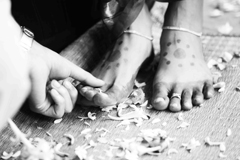
15. Saptha Padi : The seven steps. As per Hindu law, a marriage is incomplete without having taken these seven steps, supposed to be the beginning of a long-lasting friendship.
16. Pradhaana Homam: An homage to the all-powerful element, Agni, this homam is performed as the couple circle the fire, offering grain, nine types of twigs, and ghee(clarified butter) as sacrificial fuel. It is said that the fumes from this pyre cleanse the bodies of the bride and groom. Agni is, by this ritual, deemed to be a witness to the wedding.

17. Treading on the grindstone: Holding the bride’s left toe, the groom helps her tread on a grindstone, signifying that her mind be as firm as the rock she has stepped on whenever trouble comes her way.
18. Stargazing: The groom directs the bride towards the star Arundhati – named thus after the wife of the sage Vashishta, regarded as the epitome of chastity – and Dhruva, the pole star known for single-minded devotion.
19. Laaja Homam: The bride’s offering to the sacrificial fire, done with her brother’s assistance, since women are forbidden to partake in such rituals. The grains of parched rice are handed to the bride by her brother and she then gives it to the groom who, on her behalf, feeds it to the fire.
20. Showering of akshadai: Rice grains coated with turmeric are showered on the married couple by gathered elders as a blessing.
21. Griha Pravesham:The bride takes embers from the sacrificial fire with her as she leaves her old home and enters her new home to begin another phase of her life.
Images courtesy Arjoon Manohar Photography, Nrithya Randhir Photography, Ramesh Kumar Photography. Reproduced with permission.
Editor’s note:
Looking for a soul-stirring wedding ceremony? Check out these 12 beautiful temples in India where you can get married at.
























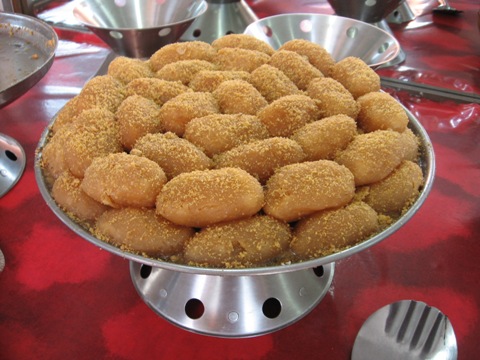

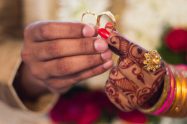














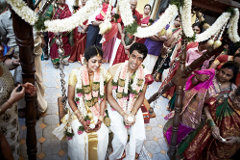
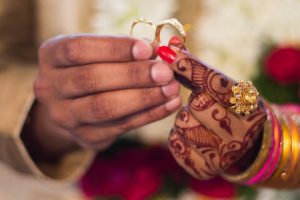

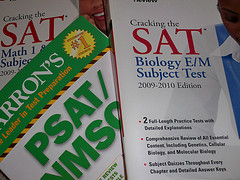



[…] Have you ever been at a Tamil Brahmin wedding, but didn’t know what the rituals were about? Here’s a guide to Tamil Brahmin weddings: Tamil Brahmin Wedding Ceremony. […]
[…] Have you ever been at a Tamil Brahmin wedding, but didn’t know what the rituals were about? Here’s a guide to Tamil Brahmin weddings: Tamil Brahmin Wedding Ceremony. […]